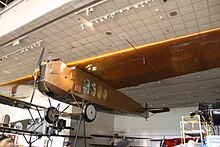Fokker F.IV
| F.IV | |
|---|---|

| |
| Fokker A-2 | |
| Role | Airliner |
| Manufacturer | Fokker |
| Designer | Reinhold Platz |
| First flight | 1921 |
| Primary user | USAAS |
| Number built | 2 |
TheFokker F.IVwas anairlinerdesigned in theNetherlandsin the early 1920s, with only two ever made, both for theUnited States Army Air Service(designatedT-2). The aircraft made the firstnon-stopcoast to coast flight of the continental United States in May 1923. The aircraft was powered by a twelve cylinder Liberty engine which was a popular engine for U.S. aircraft at this time.
One of the aircraft was preserved and is on display at theNational Air and Space Museum(the Smithsonian) in Washington, DC. in the United States.
Design and development
[edit]
The Fokker F.IV was constructed in typical Fokker style (the largest design they had yet built), as a high-wingcantilevermonoplanewith fixedtailskid undercarriage.The pilot sat in an open cockpit alongside the engine in the manner of theFokker F.III,while a cabin inside the fuselage could seat 12 passengers. Before the aircraft had even been built, the United States Army Air Service had bought two examples during a promotional visit to the country byAnthony Fokker.Built at Fokker's factory atVeereand flight-tested by Anthony Fokker himself, the two aircraft were crated and shipped to the United States where they were assembled atMcCook Fieldand given the designationT-2.Despite Fokker's hopes that increasing airline passenger numbers would create interest in aircraft of largerseating capacity,the F.IV was too large for the needs of contemporary airlines, and no further aircraft were sold.[1]
Operational history
[edit]

One of the T-2s was used for a number of long-distance flights over the next few years, culminating in the first nonstop transcontinental flight across the United States, an idea that originated with LieutenantOakley G. Kelly,one of the T-2's test pilots. The Army agreed to let Kelly have the aircraft specially modified to carry more fuel, and to install a connecting doorway between the cabin and cockpit so that he and fellow test-pilot LieutenantJohn A. Macreadycould take turns flying and resting. An extra set of controls was also installed to facilitate the handover from one pilot to the other. As modified, the T-2 would take off with 2,350 L (620 US gal) of fuel on board, making it 1,110 kg (2,450 lb) over its prescribed maximum takeoff weight.[2]
In late 1922, Kelly and Macready made two attempts at the transcontinental flight. The first was made on 5 October 1922, departingSan Diego, CaliforniaforNew York City.After 35 hours 18 minutes in the air, they were forced to abandon the attempt and land due to fog.[3]This would have been a world duration record, but without abarographon board, it could not be officially recognized by theFAI.Kelly and Macready tried again on 3 November, but this time engine trouble forced an emergency landing nearIndianapolisafter 25 hours 30 minutes.
The following year, they made a long-duration flight over a closed circuit overDayton, Ohio,remaining aloft for 36 hours, 14 minutes 8 seconds between 16 and 17 April.[4]This established a new world duration record, but also a new distance record, weight record, and eight various airspeed records.[5]On 2 May 1923, they set out from New York to attempt the transcontinental flight again, this time traveling in the opposite direction. 26 hours 50 minutes later, they landed in San Diego, having covered 4,034 km (2,521 mi).[6]Their aircraft is preserved in theNational Air and Space Museum.[7]
The other T-2 was converted into an air ambulance and given the designationA-2.
Specifications
[edit]

General characteristics
- Crew:One pilot
- Capacity:12 passengers
- Length:15.00 m (49 ft 3 in)
- Wingspan:24.80 m (81 ft 4 in)
- Height:3.34 m (11 ft 0 in)
- Wing area:34.6 m2(372 sq ft)
- Empty weight:2,250 kg (4,960 lb)
- Gross weight:3,460 kg (7,630 lb)
- Powerplant:1 ×Packard-builtLiberty L-12piston engine,298 kW (400 hp)
Performance
- Maximum speed:150 km/h (93 mph, 81 kn)
- Range:4,100 km (2,550 mi, 2,220 nmi)
- Service ceiling:3,200 m (10,500 ft)
Notes
[edit]- ^Taylor 1989, p. 405.
- ^"The Fokker 'F.IV'".Flight,29 December 1921, pp. 858–859. Retrieved: 16 September 2012.
- ^"Fine American Duration Flight".Flight,19 October 1922, p. 615. Retrieved: 16 September 2012.
- ^"Thirty-Six Hours in the Air".Flight,26 April 1923, p. 232. Retrieved: 16 September 2012.
- ^"Coast to Coast".Time,12 May 1923. Retrieved: 16 September 2012.
- ^ "Across America".Flight,10 May 1923, p. 248. Retrieved: 16 September 2012.
- ^"Endurance Records Broken".Time,28 April 1923. Retrieved: 16 September 2012.
References
[edit]- Taylor, Michael J. H.Jane's Encyclopedia of Aviation.London: Studio Editions, 1989.ISBN0-517-69186-8.
